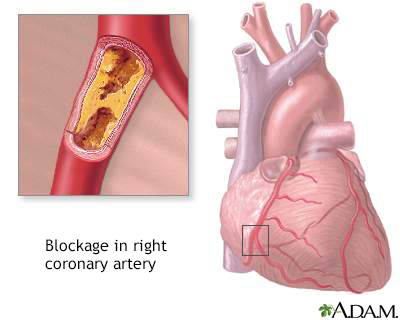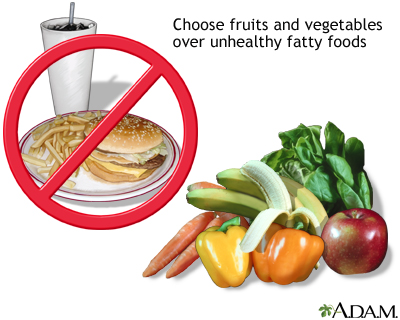Familial combined hyperlipidemia
Multiple lipoprotein-type hyperlipidemiaFamilial combined hyperlipidemia is a disorder that is passed down through families. It causes high blood cholesterol and triglyceride levels.
Triglyceride
Cholesterol is a fat (also called a lipid) that your body needs to work properly. Too much bad cholesterol in your blood can increase your chance of...

Causes
Familial combined hyperlipidemia is the most common genetic disorder that increases blood fats. It can cause early heart attacks.
Heart attacks
Most heart attacks are caused by a blood clot that blocks one of the coronary arteries. The coronary arteries bring blood and oxygen to the heart. ...

Diabetes, alcohol use, and hypothyroidism make the condition worse. Risk factors for being diagnosed with this condition include a family history of high cholesterol and early coronary artery disease.
Diabetes
Diabetes is a long-term (chronic) disease in which the body cannot regulate the amount of sugar in the blood.

Hypothyroidism
Hypothyroidism is a condition in which the thyroid gland does not make enough thyroid hormone. This condition is often called underactive thyroid....

High cholesterol
Cholesterol is a fat (also called a lipid) that your body needs to work properly. Too much bad cholesterol in your blood can increase your chance of...

Symptoms
In the early years, there may be no symptoms.
When symptoms appear, they may be due to impaired blood flow to parts of the body and include:
-
Chest pain (angina) or other signs of coronary artery disease may be present at a young age.
Chest pain
Chest pain is discomfort or pain that you feel anywhere along the front of your body between your neck and upper abdomen.
 ImageRead Article Now Book Mark Article
ImageRead Article Now Book Mark Article - Cramping of one or both calves when walking.
- Sores on the toes that do not heal.
- Sudden stroke-like symptoms, such as trouble speaking, drooping on one side of the face, weakness of an arm or leg, and loss of balance.
Stroke
A stroke occurs when blood flow to a part of the brain stops. A stroke is sometimes called a "brain attack. " If blood flow is cut off for longer th...
 ImageRead Article Now Book Mark Article
ImageRead Article Now Book Mark Article
People with this condition may develop high cholesterol or triglyceride levels as teenagers. The condition may also be diagnosed when people are in their 20s and 30s. The levels remain high all during life. Those with familial combined hyperlipidemia have an increased risk of early coronary artery disease and heart attacks. They also have higher rates of obesity and are more likely to have glucose intolerance.
Coronary artery disease
Stable angina is chest pain or discomfort that most often occurs with activity or emotional stress. Angina is due to poor blood flow through the blo...

Obesity
Obesity means weighing more than what is healthy for a given height. Obesity is a serious, chronic disease. It can lead to other health problems, i...

Exams and Tests
Blood tests will be done to check your levels of cholesterol and triglycerides. Tests will show:
- Increased LDL cholesterol
- Decreased HDL cholesterol
- Increased triglycerides
Triglycerides
The triglyceride level is a blood test to measure the amount of triglycerides in your blood. Triglycerides are a type of fat. Your body makes some t...
 ImageRead Article Now Book Mark Article
ImageRead Article Now Book Mark Article - Increased apolipoprotein B100
Apolipoprotein B100
Apolipoprotein B100 (apoB100) is a protein that plays a role in moving cholesterol around your body. It is a form of low density lipoprotein (LDL). ...
 ImageRead Article Now Book Mark Article
ImageRead Article Now Book Mark Article
Genetic testing is available for one type of familial combined hyperlipidemia.
Treatment
The goal of treatment is to reduce the risk of atherosclerotic heart disease.
Atherosclerotic heart disease
Atherosclerosis, sometimes called "hardening of the arteries," occurs when fat, cholesterol, and other substances build up in the walls of arteries. ...

LIFESTYLE CHANGES
The first step is to change what you eat. Most of the time, you will try diet changes for several months before your health care provider recommends medicines. Diet changes include lowering the amount of saturated fat and refined sugar.
Saturated fat
Saturated fat is a type of dietary fat. It is one of the unhealthy fats, along with trans fat. These fats are most often solid at room temperature....

Here are some changes you can make:
- Eat less beef, chicken, pork, and lamb
- Substitute low-fat dairy products for full-fat ones
- Avoid packaged cookies and baked goods that contain trans fats
- Reduce the cholesterol you eat by limiting egg yolks and organ meats
It may help to talk to a dietitian who can give you advice about changing your eating habits. Weight loss and regular exercise may also help lower your cholesterol level.
Changing your eating habits
A healthy diet is an important factor in reducing your risk for heart disease.

MEDICINES
If lifestyle changes do not change your cholesterol levels enough, or you are at very high risk for atherosclerotic heart disease, your provider may recommend that you take medicines. There are several types of medicines to help lower blood cholesterol levels.
The medicines work in different ways to help you achieve healthy lipid levels. Some are better at lowering LDL cholesterol, some are good at lowering triglycerides, while others help raise HDL cholesterol.
The most commonly used, and most effective medicines for treating high LDL cholesterol are called statins. They include lovastatin (Mevacor), pravastatin (Pravachol), simvastatin (Zocor), fluvastatin (Lescol), atorvastatin (Lipitor), rosuvastatin (Crestor), and pitivastatin (Livalo).
Other cholesterol-lowering medicines include:
- Bile acid-sequestering resins.
- Ezetimibe.
- Fibrates (such as gemfibrozil and fenofibrate).
-
Nicotinic acid.
Nicotinic acid
Niacin is a type of B vitamin. It is a water-soluble vitamin. It is not stored in the body. Water-soluble vitamins dissolve in water. Leftover am...
 ImageRead Article Now Book Mark Article
ImageRead Article Now Book Mark Article - PCSK9 inhibitors, such as alirocumab (Praluent) and evolocumab (Repatha) These represent a newer class of medicines to treat high cholesterol.
Outlook (Prognosis)
How well you do depends on:
- How early the condition is diagnosed
- When you start treatment
- How well you follow your treatment plan
Without treatment, heart attack or stroke may cause early death.
Even with medicine, some people may continue to have high lipid levels that increase their risk for heart attack.
Possible Complications
Complications may include:
- Early atherosclerotic heart disease
- Heart attack
- Stroke
When to Contact a Medical Professional
Seek medical care right away if you have chest pain or other warning signs of a heart attack.
Contact your provider if you have a personal or family history of high cholesterol levels.
Prevention
A diet that is low in cholesterol and saturated fat may help to control LDL levels in people at high risk.
If someone in your family has this condition, you may want to consider genetic screening for yourself or your children. Sometimes, younger children may have mild hyperlipidemia.
Hyperlipidemia
Cholesterol is a fat (also called a lipid) that your body needs to work properly. Too much bad cholesterol in your blood can increase your chance of...

It is important to control other risk factors for early heart attacks, such as smoking.
References
Genest J, Mora S, Libby P. Lipoprotein disorders and cardiovascular disease. In: Libby P, Bonow RO, Mann DL, Tomaselli GF, Bhatt DL, Solomon SD, eds. Braunwald's Heart Disease: A Textbook of Cardiovascular Medicine. 12th ed. Philadelphia, PA: Elsevier; 2022:chap 27.
Robinson JG. Disorders of lipid metabolism. In: Goldman L, Cooney KA, eds. Goldman-Cecil Medicine. 27th ed. Philadelphia, PA: Elsevier; 2024:chap 190.
-
Coronary artery blockage - illustration
Atherosclerosis is a common disorder of the arteries. Fat, cholesterol, and other substances collect in the walls of arteries. Larger accumulations are called atheromas or plaque and can damage artery walls and block blood flow. Severely restricted blood flow in the heart muscle leads to symptoms such as chest pain.
Coronary artery blockage
illustration
-
Healthy diet - illustration
For a healthy diet, replace unhealthy and fattening foods with healthier alternatives, such as fresh fruits and vegetables.
Healthy diet
illustration
-
Coronary artery blockage - illustration
Atherosclerosis is a common disorder of the arteries. Fat, cholesterol, and other substances collect in the walls of arteries. Larger accumulations are called atheromas or plaque and can damage artery walls and block blood flow. Severely restricted blood flow in the heart muscle leads to symptoms such as chest pain.
Coronary artery blockage
illustration
-
Healthy diet - illustration
For a healthy diet, replace unhealthy and fattening foods with healthier alternatives, such as fresh fruits and vegetables.
Healthy diet
illustration
Review Date: 5/8/2024
Reviewed By: Thomas S. Metkus, MD, Assistant Professor of Medicine and Surgery, Johns Hopkins University School of Medicine, Baltimore, MD. Also reviewed by David C. Dugdale, MD, Medical Director, Brenda Conaway, Editorial Director, and the A.D.A.M. Editorial team.





